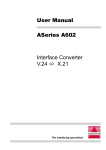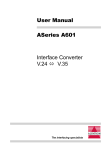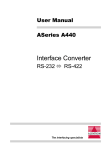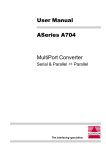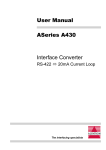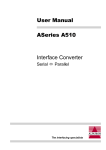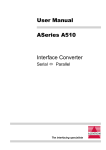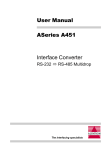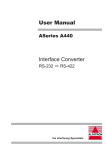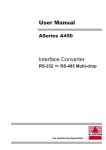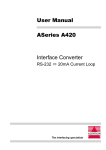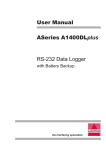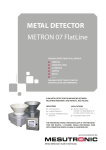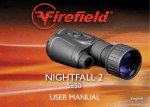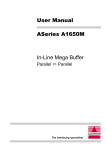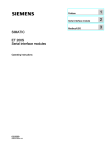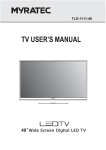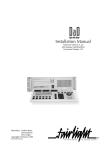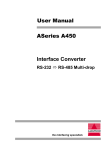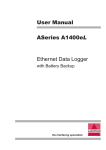Download ASeries A600 User Manual Interface Converter X.21 ó V.35
Transcript
User Manual ASeries A600 Interface Converter X.21 ó V.35 The interfacing specialists A600 User Manual Version 1.10 May 1999 COPYRIGHTS All rights reserved. This document may not, in whole or part, be copied, photocopied, reproduced, translated, or reduced to any electronic medium or machine readable form without the express permission in writing from Alfatron Pty Ltd. Copyright 1999 © Alfatron Pty Ltd DISCLAIMER Alfatron Pty Ltd has made every attempt to ensure that the information contained in this document is accurate and complete. Alfatron Pty Ltd makes no representation or warranties of merchantability or fitness for any particular purpose. Alfatron Pty Ltd reserves the right to make changes to this document at any time, without notice. Therefore, Alfatron Pty Ltd assumes no liability for damages incurred directly or indirectly from errors, omissions or discrepancies with the hardware and the manual. TRADEMARKS All Company and Product names are trademarks of the Company or Manufacturer respectively. WARRANTY Alfatron warrants its products against defects in materials and workmanship for a period of one year from receipt by the customer. All warranty is carried out on a return to depot basis unless an alternative warranty coverage has been arranged. WARRANTY EXCLUSIONS The above warranty shall not apply to defects resulting from improper or inadequate maintenance by the customer, unauthorised modifications or misues, operation outside the environmental specifications for the product, damage due to power surges, lightening strikes or any other phenomenon outside normal operational specifications. Alfatron Pty Ltd ACN: 005 410 819 P.O. Box 4161 Unit 9/36 New St. Ringwood VIC 3134 AUSTRALIA Web Site: www.alfatron.com.au A600 User Manual 1.0 PRODUCT DESCRIPTION The ASeries A600 is an X.21 bis <> CCITT V.35 interface converter and provides bidirectional data communication between the X.21 and V.35 communication standards at data rates up to 2 Mbits/second. No changes are made to either data or timing signals and the A600 is transparent to data and any introduced protocol. Both the X.21 and V.35 ports of the A600 may be configured to either Data Communications Equipment (DCE) or Data Terminal Equipment (DTE) via an internal 50-pin jumper. Internal jumpers are also used for the selection of Clock Sources and Handshaking lines. Possible A600 configurations are as follows: l V.35 (DCE) to X.21 (DTE) in this configuration the X.21 Control Signal source is jumper selected between either V.35 Request To Send (RTS) or V.35 Data Terminal Ready (DTR). l V.35 (DTE) to X.21 (DCE) in this configuration the X.21 Signal Timing source is jumper selected between either V.35 Serial Clock Transmit (SCT) or V.35 Serial Clock Receive (SCR). The physical layout of the ASeries A600 is as follows: Figure 1-1 A600 viewed from front and rear Light Emitting Diodes (LEDs) on Rear Panel The two LEDs shown on the rear panel in Figure 1-1 are a convenient method of identifying the DTE or DCE status of each port: l Bi-colour LED is 'RED' if corresponding port is 'DTE'. l Bi-colour LED is 'GREEN' if corresponding port is 'DCE'. 1 A600 User Manual 2.0 INSTALLATION 2.1 Selecting a Port as DCE or DTE Before installing the A600 please make sure that the 50-pin jumper is inserted into the correct DCE or DTE position to meet your requirements. In the majority of cases when synchronous serial communications is used, the DCE will provide the 'Clock Signal' to the DTE device, therefore the A600 supports the following two configurations of X.21 and V.35: (i) X.21-DTE (Terminal) to V.35-DCE (Modem) (ii) X.21-DCE (Modem) to V.35-DTE (Terminal) these configurations are selected by removing the cover of the A600 and inserting the 50pin jumper into the appropriate socket, J201 or J202, located on the Printed Circuit Board (PCB) of the A600 as shown below: Figure 2-1 Configuration jumper blocks on A600 PCB WARNING: 240Volt power must be removed from the A600 before the cover is removed and the 50-pin jumper re-located. Two combinations which are NOT supported by the A600 are as follows: (iii) X.21-DTE (Terminal) to V.35-DTE (Terminal) (iv) X.21-DCE (Modem) to V.35-DCE (Modem) In the case of DTE to DTE (iii), no timing source exists for synchronous communications as timing is normally supplied by the DCE device. In the case of DCE to DCE (iv), there are two timing sources which will create an ambiguous situation. 2 A600 User Manual 2.2 Selecting V.35 Clock Source The V.35 interface has two differential clock sources, Serial Clock Transmit (SCT) and Serial Clock Receive (SCR). In the X.21 (DCE) to V.35 (DTE) case, one of the two clock sources must be selected as a source for the X.21 interface Signal Element Timing signal. Because the clock source is a differential signal it requires two lines. Therefore the A600 provides a pair of jumper blocks, J203 and J204 (shown in Figure 2-2), to select the two lines. These jumpers must always be moved as a pair. To select V.35 (SCT) as the clock source, move the pair of jumpers to the 'TxCLK' position. To select V.35 (SCR) as the clock source, move the pair of jumpers to the 'RxCLK' position. The factory default setting is V.35 (SCT) with jumpers in the 'TxCLK' position. Figure 2-2 2.3 Selecting V.35 Handshaking Lines The X.21 interface Control line is used to drive the V.35 interface DTR or RTS handshaking lines. The J205 jumper block has two positions to define which of the handshaking lines, DTR or RTS, is driven by the X.21 Control line. The settings for J205 are shown in Figure 2-3 and are used in the following two situations: (a) if the A600 is set for X.21 (DCE) and V.35 (DTE) then the jumper in J205 may be set for either DTR or RTS, according to your requirements. (b) if the A600 is set for X.21 (DTE) and V.35 (DCE) then the jumper in J205 must be set to the RTS position. In both cases the line which is not selected is pulled to +12V via a 4.7KW resistor. The factory default for jumper J205 is the RTS position. Figure 2-3 3 A600 User Manual 2.4 Front Panel LED Indicators The LED indicators in the A600 provide a function similar to that of a breakout box. They show the level of the appropriate TTL signal rather than a level directly present on the communications line. The signal names correspond to the port which is selected as DTE. For example, if the A600 is configured as X.21 (DTE) / V.35 (DCE) and the 'RD' LED is active then this refers to the activity on the X21 port 'Ra / Rb' line pair. The advantage of this approach is that all communication line signals are converted internally by the A600 to TTL levels and then converted to a level specific to either the X.21 or V.35 interface. The TTL level signals therefore provide a common reference to both ends of the converter and show the signals as seen by the converter regardless of the type of interface configuration. The A600 has six LED indicators on its front panel. The LED marked 'Power' is Yellow and indicates that the A600 has operating power. The other five LEDs are Red/Green bi-colour indicators with the following meanings: Configured for X.21 (DCE) and V.35 (DTE) l Clock - Data Clock signal from V.35 lines STR(a/b) or SCT(a/b) l DCD - Data Carrier Detect from V.35 device l RTS - Handshaking signal to V.35 device, RTS or DTR l RD - Data received from V.35 device l TD - Data sent to V.35 device Configured for X.21 (DTE) and V.35 (DCE) l Clock - Data Clock signal from X.21 line S(a/b) l IND - Indicator signal to X.21 device l CTRL - Control signal to V.35 device l RD - Data received from X.21 device l TD - Data sent to X.21 device The convention used on these bi-colour LEDs is as follows: l Bi-colour LED is 'RED' if corresponding TTL signal is 'HIGH'. l Bi-colour LED is 'GREEN' if corresponding TTL signal is 'LOW'. 4 A600 User Manual 2.5 Rear Panel LED Indicators The two bi-colour LEDs on the rear panel are shown in Figure 1-1. They identify the DTE or DCE status of the port closest to that LED and are determined by the internal 50-pin jumper. These LEDs provide a convenient method of identifying the status of each port without opening the case: l Bi-colour LED is 'RED' if corresponding port is 'DTE'. l Bi-colour LED is 'GREEN' if corresponding port is 'DCE'. 3.0 CABLE REQUIREMENTS Alfatron Pty Ltd recommends the use of shielded cable with all of its products. Shielding reduces Electro Magnetic Radiation and improves noise immunity. This helps minimise interference to other equipment and will improve communications reliability. The recommended cable construction is as follows: l Take the shield (surrounding cable wires) and solder it to the Frame Ground (FG) pin. If FG is not available, use Signal Ground (SG) but in this case always use a separate wire for ground which is connected at both ends. If a metalised backshell is used then it is preferred that the cable shield make 360o contact with the backshell at the point of entry. l The shield must be connected at both ends of the cable. 4.0 FACTORY SETTINGS The A600 is factory pre-set to the following configuration: l X.21 (DCE) to V.35 (DTE) l V.35 Clock Source (J203 and J204) is set to 'TxCLK' l V.35 Handshaking Line (J205) is set to RTS 5 A600 User Manual 5.0 INTERFACE PIN ASSIGNMENTS 5.1 X.21 Interface Pin Assignments The direction of the signal lines depends on the selection of the X.21 port as either DTE or DCE via the 50-pin jumper, please refer to Section 2.1. 6 3LQ 1R 6LJQDO 1DPH )XOO6LJQDO1DPH $3RUW ;'7( $3RUW ;'&( )* )UDPH*URXQG 7D 7UDQVPLWD 2XWSXW ,QSXW &D &RQWUROD 2XWSXW ,QSXW 5D 5HFHLYHD ,QSXW 2XWSXW ,D ,QGLFDWRUD ,QSXW 2XWSXW 6D 6LJQDO&ORFND ,QSXW 2XWSXW 1RWDVVLJQHG 6* 6LJQDO*URXQG 7E 7UDQVPLWE 2XWSXW ,QSXW &E &RQWUROE 2XWSXW ,QSXW 5E 5HFHLYHE ,QSXW 2XWSXW ,E ,QGLFDWRUE ,QSXW 2XWSXW 6E 6LJQDO&ORFNE ,QSXW 2XWSXW 1RWDVVLJQHG 1RWDVVLJQHG A600 User Manual 5.2 V.35 Interface Pin Assignments The direction of the signal lines depends on the selection of the V.35 port as either DTE or DCE via the 50-pin jumper, please refer to Section 2.1. 3LQ 1R 6LJQDO 1DPH )XOO6LJQDO1DPH $3RUW 9'7( $3RUW 9'&( $ )* )UDPH*URXQG % 6* 6LJQDO*URXQG & 576 5HTXHVW7R6HQG 2XWSXW ,QSXW ' &76 &OHDU7R6HQG ,QSXW 2XWSXW ( '65 'DWD6HW5HDG\ ,QSXW 2XWSXW ) '&' 'DWD&DUULHU'HWHFW ,QSXW 2XWSXW + '75 'DWD7HUPLQDO5HDG\ 2XWSXW ,QSXW 3 6'D 6HQG'DWDD 2XWSXW ,QSXW 5 5'D 5HFHLYH'DWDD ,QSXW 2XWSXW 6 6'E 6HQG'DWDE 2XWSXW ,QSXW 7 5'E 5HFHLYH'DWDE ,QSXW 2XWSXW 9 6&5D 6LJQDO&ORFN5HFHLYHD ,QSXW 2XWSXW ; 6&5E 6LJQDO&ORFN5HFHLYHE ,QSXW 2XWSXW < 675D 6LJQDO&ORFN7UDQVPLWD ,QSXW 2XWSXW $$ 675E 6LJQDO&ORFN7UDQVPLWE ,QSXW 2XWSXW Note: DTE external clock (SCTE) pair, pins U and W, is not supported by the A600. 7 A600 User Manual 6.0 SPECIFICATIONS X.21 Port: X.21 bis Select as DTE or DCE DB-15 female connector V.35 Port: CCITT V.35 Compatible Select as DTE or DCE 34-pin V.35 female connector Front LED Indicators: Clock X.21 (IND) / V.35 (DCD) X.21 (CTRL) / V.35 (RTS) Receive Data X.21 and V.35 Transmit Data X.21 and V.35 Power Rear LED Indicators: X.21 Port Status, DTE or DCE (Bi-colour Red/Green) V.35 Port Status, DTE or DCE (Bi-colour Red/Green) Power Supply: 240V AC 50Hz Standard IEC male socket Dimensions: 45mm x 120mm x 190mm Weight: 920 grams Operating Temperature: 0° to 40° C Stroage Temperature: (Bi-colour Red/Green) (Bi-colour Red/Green) (Bi-colour Red/Green) (Bi-colour Red/Green) (Bi-colour Red/Green) (Yellow) -20° to 70° C All specifications subject to change without notice 8 N42 DECLARATION OF CONFORMITY according to the European Commissions EMC Directive 89/336/EEC We, of, Name of Manufacturer: Address of Manufacturer: Australian Company Number: ALFATRON PTY. LTD UNIT 9, 36 NEW ST. RINGWOOD VIC 3134 AUSTRALIA ACN: 005 410 819 declare under sole responsibility that the product: Product Name: ASeries X.21 to V.35 Interface Converter Model Number: A600 to which this declaration relates is in conformity with the following standards: CISPR-22 / EN 55022 class B IEC 801-2 / prEN55024-2 IEC 801-3 / prEN55024-3 IEC 801-4 / prEN55024-4 EMI from Information Technology Equipment (ITE) Electro Static Discharge Immunity Radiated RF Immunity Electrical Fast Transients Immunity











